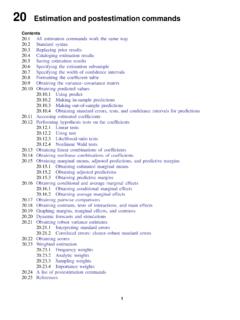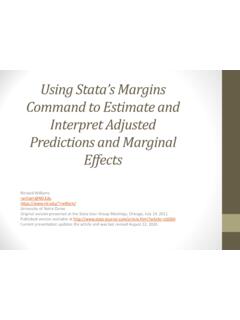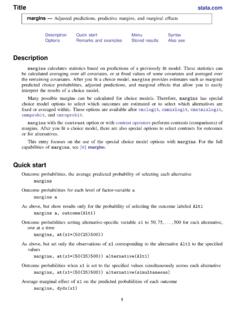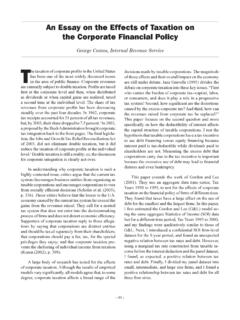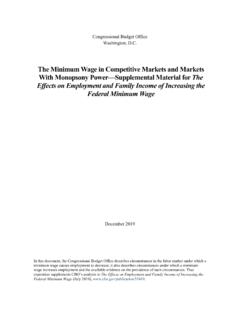Transcription of Marginal Effects in Probit Models: Interpretation and Testing
1 ECON 452* -- NOTE 15: Marginal Effects in Probit Models Abbott ECON 452* -- NOTE 15 Marginal Effects in Probit Models: Interpretation and Testing This note introduces you to the two types of Marginal Effects in Probit models: Marginal index Effects , and Marginal probability Effects . It demonstrates how to calculate these Effects for both continuous and categorical explanatory variables. 1. Interpreting Probit Coefficients A Generic Probit Model The conventional formulation of a binary dependent variable model assumes that an unobserved (or latent) dependent variable is generated by a classical linear regression model of the form *iY iikk2i21i10iTi*iuXXXuxY+ ++ + + =+ =L (1) where: *iY = a continuous real-valued index variable for observation i that is unobservable, or latent; Tix = , a 1 K row vector of regressor values for )XXX1(ik2i1iL observation i; = , a K 1 column vector of regression coefficients; Tk210)( L Tix = a 1 1 scalar called the index function for observation i.
2 Iu = an iid random error term for observation i. ),0(N2 The observable outcomes of the binary choice problem are represented by a binary indicator variable Yi that is related to the unobserved dependent variable as follows: *iY Yi = 1 if > 0 ( ) *iYYi = 0 if 0 ( ) *iY ECON 452* -- Note 15: Filename .. Page 1 of 9 pages ECON 452* -- NOTE 15: Marginal Effects in Probit Models Abbott The random indicator variable Yi represents the observed realizations of a binomial process with the following probabilities: )0uxPr()0 YPr()1 YPr(iTi*ii>+ =>== ( ) )0uxPr()0 YPr()0 YPr(iTi*ii + = == ( ) Probit models analytically represent the binomial probabilities ( ) and ( ) in terms of the standard normal ()Z as follows.
3 () =>==Ti*iix)0 YPr()1 YPr( ( ) () = ==Ti*iix1)0 YPr()0 YPr( ( ) Interpretation of the Probit coefficient vector Under the zero conditional mean error assumption, equation (1) implies that ()()() =+ =TiTiiTiTiTi*ixxuExxExYE since ()0xuETii=. (5) The index function (or regression function) is thus the conditional mean value of the latent random variable for given values of the regressors. Tix*iY The slope coefficients j (j = 1, .., k): If all explanatory variables are continuous and enter the index function linearly, the partial derivatives of regression function (5) with respect to the individual regressors are the slope coefficients j (j = 1.)
4 , k): ()jijikkijj1i10ijTiijTi*iX)XXX(XxXxYE = ++ ++ + = = LL. But if some of the explanatory variables are binary or enter the index function nonlinearly, the partial derivatives of regression function (5) are not so simply interpreted. ECON 452* -- Note 15: Filename .. Page 2 of 9 pages ECON 452* -- NOTE 15: Marginal Effects in Probit Models Abbott 2. Two Types of Marginal Effects in Probit Models For each explanatory variable, there are two types of Marginal Effects in binary dependent variables models. Marginal Index Effects Marginal index Effects are the partial Effects of each explanatory variable on the Probit index function.
5 Tix Case 1: Xj is a continuous explanatory variable Marginal index effect of variable Xj ()ijTiijTi*iXxXxYE = Case 2: Xj is a binary explanatory variable (a dummy or indicator variable) The Marginal index effect of a binary explanatory variable equals 1. the value of the index function when X Tixij = 1 and the other regressors equal fixed values minus 2. the value of the index function when X Tixij = 0 and the other regressors equal the same fixed values Formal Definition: Define two different vectors of regressor values: Ti1x = any vector of regressor values with Xij = 1; Ti0x = the same vector of regressor values but with Xij = 0.
6 The Marginal index effect of the binary (dummy) variable Xj is: Marginal index effect of Xj = Ti0Ti1xx ECON 452* -- Note 15: Filename .. Page 3 of 9 pages ECON 452* -- NOTE 15: Marginal Effects in Probit Models Abbott Limitation: Marginal index Effects are difficult to interpret because it is difficult to interpret and impossible to measure the latent dependent variable . *iY Marginal Probability Effects Marginal probability Effects are the partial Effects of each explanatory variable on the probability that the observed dependent variable Yi = 1, where in Probit models ()1 YPri= = () Tix = standard normal evaluated at.
7 Tix Case 1: Xj is a continuous explanatory variable Marginal probability effect of variable Xj ()()ijTiijiXxX1 YPr = = Using the chain rule of differentiation, we can obtain a general expression for the Marginal probability effect of a continuous explanatory variable Xj: Marginal probability effect of Xj = ()()()ijTiTiijTiTiTiijTiXxxXx)x(dxdXx = = where ()())x(dxdxTiTiTi = = the value of the standard normal at . TixijTiXx = the Marginal index effect of Xj ECON 452* -- Note 15: Filename .. Page 4 of 9 pages ECON 452* -- NOTE 15: Marginal Effects in Probit Models Abbott Case 2: Xj is a binary explanatory variable (a dummy or indicator variable) The Marginal probability effect of a binary explanatory variable equals 1.
8 The value of () Tix when Xij = 1 and the other regressors equal fixed values minus 2. value of () Tix when Xij = 0 and the other regressors equal the same fixed values Formal Definition: Define two different vectors of regressor values: Ti1x = any vector of regressor values with Xij = 1; Ti0x = the same vector of regressor values but with Xij = 0. The Marginal probability effect of the binary (dummy) variable Xj is: Marginal probability effect of Xj = ()() Ti0Ti1xx. Relationship Between the Two Marginal Effects for Continuous Variables Compare the Marginal index effect and Marginal probability effect of a continuous explanatory variable Xj.
9 Marginal index effect of variable Xj = ijTiXx Marginal probability effect of variable Xj = ()()ijTiTiijTiXxxXx = Relationship: For a continuous explanatory variable Xj, the Marginal probability effect is proportional to the Marginal index effect of Xj, where the factor of proportionality is the standard normal at : Tix Marginal probability effect of Xj = () Tix Marginal index effect of Xj ECON 452* -- Note 15: Filename .. Page 5 of 9 pages ECON 452* -- NOTE 15: Marginal Effects in Probit Models Abbott 3.
10 Marginal Index and Probability Effects in Probit Models A Simple Probit Model i3ii6i53i422i32i21i10iTi*iuXDDXXXXuxY+ + + + + + + =+ = where: Xi1, Xi2 and Xi3 are continuous explanatory variables Di is a binary (or dummy) explanatory variable defined such that Di = 1 if observation i exhibits some attribute, = 0 otherwise. The index function is: 3ii6i53i422i32i21i10 TiXDDXXXXx + + + + + + = Xi1 enters the index function linearly. Xi2 enters the index function nonlinearly. Xi3 enters the index function nonlinearly, interacted with Di. Di enters the index function nonlinearly, interacted with Xi3. The observed binary dependent variable Yi is related to the unobserved dependent variable as follows: *iY Yi = 1 if > 0 *iYYi = 0 if 0 *iY The binomial probabilities )1 YPr(i= and )0 YPr(i= are analytically represented in Probit models in terms of the standard normal : ()Z () =>==Ti*iix)0 YPr()1 YPr( = ()3ii6i53i422i32i21i10 XDDXXXX + + + + + + () = ==Ti*iix1)0 YPr()0 YPr( = 1 ()3ii6i53i422i32i21i10 XDDXXXX + + + + + + ECON 452* -- Note 15: Filename.


